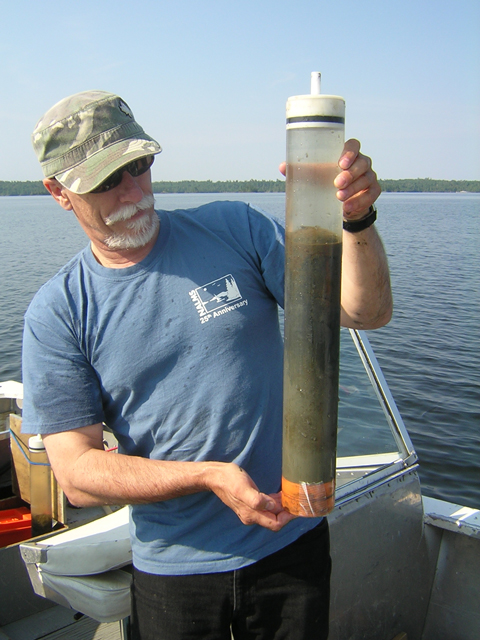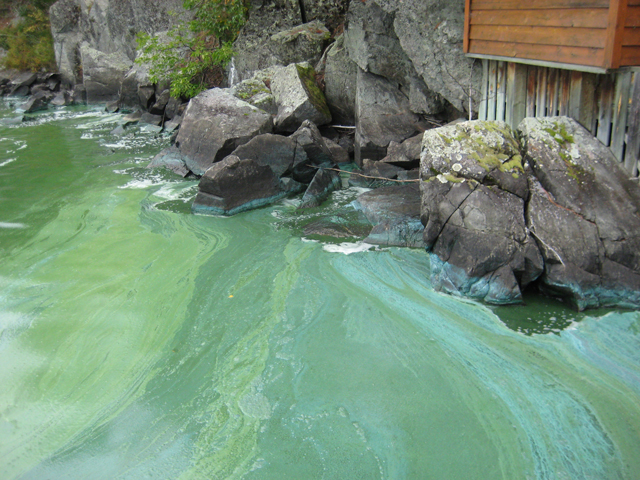In this article, Bev Clark takes a look at what we've learned about Lake of the Woods from some of the key science published in the 2017 special issue of the Journal of Lake and Reservoir Management that was devoted entirely to Lake of the Woods. How has the lake changed? Are we still paying for our past sins from phosphorus pollution built up in the lake bottom? And what role does climate change have?
By Bev Clark
 Bev Clark, holding sediment core from Lake of the Woods. Using a technique called paleolimnology, the history of the lake can be inferred from the lake sediment layersScience provides understanding. Understanding provides tools. At the end of the process, you may end up with a space pen that writes upside down, or a drug or operation that saves your life, or antilock brakes in your car.
Bev Clark, holding sediment core from Lake of the Woods. Using a technique called paleolimnology, the history of the lake can be inferred from the lake sediment layersScience provides understanding. Understanding provides tools. At the end of the process, you may end up with a space pen that writes upside down, or a drug or operation that saves your life, or antilock brakes in your car.
In the scientific process there’s an invisible line. To the left of the line are the things that you don’t understand and problems with no solutions. To the right of the line are tools and solutions from the insights science provided. The Lake of the Woods Rainy River basin is a hotbed of science complete with invisible lines.
I was chatting recently with a colleague involved with a science review for the Lake of the Woods Rainy River Basin. He said the basin is one of the most intensively studied watersheds in North America, if not the world. Certainly, many large ecosystems have been studied for long periods of time, but when it comes to being intensively studied, I think he might be right. A case in point…
In December 2017, the North American Lake Management Society published a special issue of their journal, Lake and Reservoir Management, dedicated to research in the Lake of the Woods basin. A special issue in a scientific journal highlights a topic’s priority issues, focusing on the most current understanding using recent scientific papers. It’s trying to move the invisible line further to the left.
Since the early days algal blooms and nutrients in Lake of the Woods have raised compelling questions. For many years we have known blue green algal blooms are fueled by excess phosphorus in the water, but there are many more things we don’t know. How much phosphorus is too much? What are the other things driving algal blooms? What do we need to do to control them? Are the old nutrients in the sediments from days gone by still impacting algal blooms? Are things getting better or worse?
 The special issue contained 11 scientific papers and 8 of them were related to nutrients or algal blooms. In the beginning we needed to know whether the old legacy phosphorus loads in the sediments of Big Traverse Bay were contributing to current nutrient and algal bloom conditions in the lake. Several papers in the special issue try to get to the bottom of this (pun intended) but reveal other changes that make these not so simple questions even more complicated.
The special issue contained 11 scientific papers and 8 of them were related to nutrients or algal blooms. In the beginning we needed to know whether the old legacy phosphorus loads in the sediments of Big Traverse Bay were contributing to current nutrient and algal bloom conditions in the lake. Several papers in the special issue try to get to the bottom of this (pun intended) but reveal other changes that make these not so simple questions even more complicated.
Three central papers in the special issue caught my eye, because they have similar conclusions based on different approaches. They show Lake of the Woods has changed. Not back towards where it was before industrialization, but to a new and different steady state.
The researchers in these three studies use a technique called paleolimnology. This tool relies on the history stored in lake sediments. Cores extracted from the bottom of the lake are sectioned into many thin slices. The historical date when each slice was deposited in the lake bottom is determined and then the researchers can infer by the fossil algae preserved in the slice what the water chemistry and climate conditions were at that time. Other aspects of the sediment slices, such as chemistry, pigments and the presence of other fossils, can help to recreate the history of the lake.
 Blue-green algae bloom, Coney Island, Lake of the WoodsIn the first paper, Reavie et al. showed major changes in the types of algae in the water following the peak phosphorus loads of the mid 20th century. Algae types that prefer higher nutrients are now in the lake. So, the system is different than it was before the high phosphorus loading years. Reavie describes a human enriched system that has undergone great changes due to fertilization in the mid-to-late 20th century. Also, Reavie’s studies indicate a second period of change reflected in the most recent sediments of the lake. Since even the 1980s additional changes in algae composition have occurred, despite progress in reducing nutrient loads. This is thought to be due to multiple external influences including climate change.
Blue-green algae bloom, Coney Island, Lake of the WoodsIn the first paper, Reavie et al. showed major changes in the types of algae in the water following the peak phosphorus loads of the mid 20th century. Algae types that prefer higher nutrients are now in the lake. So, the system is different than it was before the high phosphorus loading years. Reavie describes a human enriched system that has undergone great changes due to fertilization in the mid-to-late 20th century. Also, Reavie’s studies indicate a second period of change reflected in the most recent sediments of the lake. Since even the 1980s additional changes in algae composition have occurred, despite progress in reducing nutrient loads. This is thought to be due to multiple external influences including climate change.
In the second paper, Edlund et al. developed a phosphorus budget for the south basin that showed much of the old legacy phosphorus in the sediments has been depleted through outflow and burial. The effects of this legacy pool of phosphorus to the overlying water are now minimal. Phosphorus in the water was higher in the 1950s-1970s but the new steady state existing under the lower loads from the Rainy River in recent decades and lower nutrients in the in the water has created a system with more algae than would be expected for the phosphorus that is available. This is a counterintuitive decoupling of the link between phosphorus and algal production.
We have ended up with a new aquatic ecosystem that we do not entirely understand. Seasonal changes in the loads, shifting nutrient limitation, and climate warming are all playing a role in the new system. Edlund suggests that the system is sensitive to external P loading and the lake could respond to further load reductions, if further reductions are possible.
This is an incredible encouraging notion – that the legacy effects are behind us and the lake has shown that it can respond to load reductions from the watershed.
In the third paper this change to a new system was also noted by Paterson et al. who showed that recent increases in chlorophyll, a component of algae, were more correlated to climate change variables than to the changes that have occurred to phosphorus concentrations in the lake that by many measures has declined. Seems a change is in the air, and in the water.
The special issue of Lake and Reservoir Management tried to tackle many of the outstanding questions with respect to nutrients and algae in Lake of the Woods. All to help define where this invisible line is. We are definitely beginning to figure this thing out. Am I the only one who noticed that the effects of climate change are noted by all three of these researchers? The elephant in the room is right over there…in the corner…can’t you see it?
For more detail you should read Mark Edlund’s excellent article Unlocking Lake of the Woods.
www.lowwsf.com/blog/30-unlocking-lake-of-the-woods
The newest information provided by these papers in Lake and Reservoir Management is shared between researchers who now have a better understanding of how the ecosystem is responding to change, and it all comes with a new set of questions. This is science.
Note: Abstracts for the 11 studies included in the Lake of the Woods Special issue of the Journal of Lake and Reservoir Management are available at the Journal publisher https://www.tandfonline.com/toc/ulrm20/33/4?nav=tocList Some of the full scienctific papers are available "unlocked" - others not as this is a paid subscription journal. If there's a specific paper you'd like to read, contact Todd Sellers
 This article was written for the Lake of the Woods Water Sustainability Foundation as part of the foundation’s project: “Enhancing capacity for collaborative governance in the Lake of the Woods Basin”
This article was written for the Lake of the Woods Water Sustainability Foundation as part of the foundation’s project: “Enhancing capacity for collaborative governance in the Lake of the Woods Basin”
